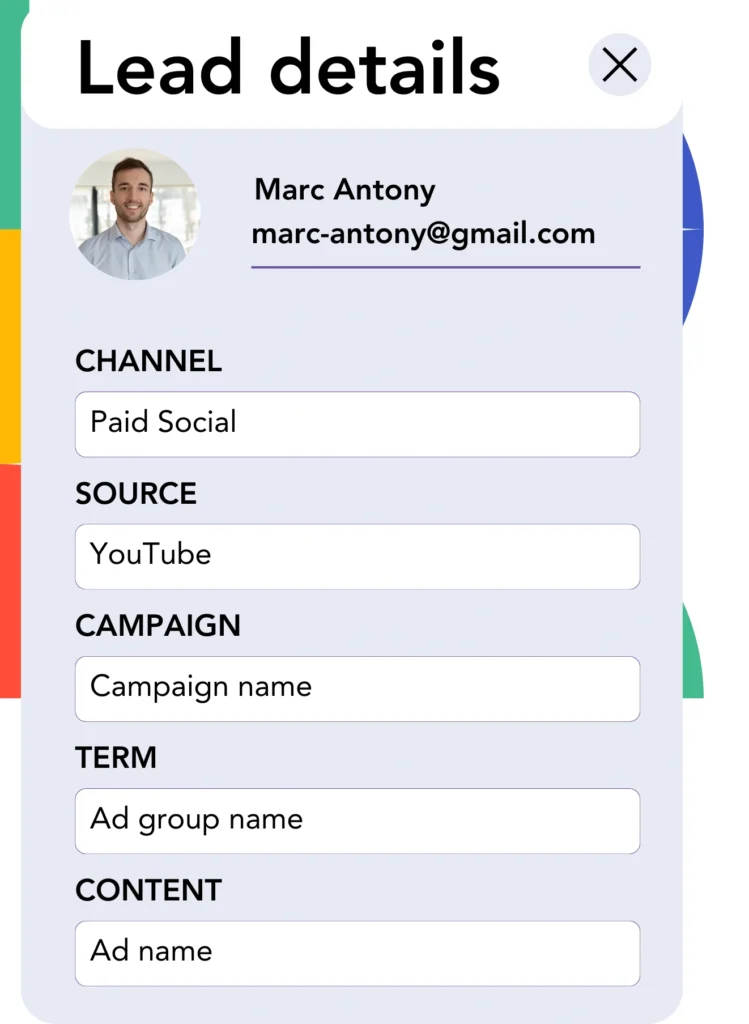Leads flow from YouTube into Nutshell CRM, yet associating each one with a specific YouTube ad is impossible. Once a lead becomes a customer, the issue continues, connecting them back to the exact YouTube ad isn’t possible.
This lack of tracking prevents you from measuring the success of your YouTube ads, making it difficult to determine which ads bring in leads and customers. As a result, you continue spending without knowing each ad’s value.
Luckily, there’s a reliable way to connect each lead with the specific YouTube campaign, ad group, and ad that produced it.
We’ll move through this one step at a time!
How to Track YouTube Ads in Nutshell CRM
Step 1: Add Leadsources in the head tag of your website

Leadsources helps you track the origin of your leads. Once on your site, it captures up to 7 pieces of source information for each lead.
➡️ Sign up to Leadsources.io for free
➡️ Add the Leadsources tracking code to your site
Step 2: Add the UTM parameters to your YouTube Ads

In your ad URL, insert UTM parameters to track campaign, ad group, and ad details from YouTube ads. You can use the following suggestions:
UTM_source=YouTubeUTM_campaign=campaign-nameUTM_term=ad-group-nameUTM_content=ad-name
The URL should end up looking like this:
https://www.yourdomain.com/?&UTM_source=youtube&UTM_campaign=campaign-name&UTM_term=ad-group-name&UTM_content=ad-nameNote: Leadsources captures lead source data without needing UTM parameters, ensuring every lead is tracked comprehensively.
Step 3: Add the hidden fields in your form

Hidden fields are invisible form elements that store information which is submitted together with the form data.
Leadsources captures the lead source data in hidden fields. When the lead submits the form, YouTube Ads data is automatically filled into these fields.
Step 4: Capture the YouTube Ads data in Nutshell CRM

When users land on your site after clicking your ads, Leadsources fetches YouTube campaign, ad group, ad data, and more.
Leadsources then adds the YouTube ad data to the hidden fields of your form.
After submitting the form, the YouTube ad data and lead details will be available in Nutshell CRM (this requires connecting your form to Nutshell CRM).
How does Leadsources work?
Each time a visitor comes to your site, Leadsources fetches YouTube ad data and populates it into the hidden fields of your form. Once the form is completed and submitted, this data, along with the lead’s details, is sent to Nutshell CRM.
Leadsources compiles and tracks lead source data for each lead:
| Lead source data | Fetched automatically |
| Channel | ✅ |
| Source | ✅ |
| Campaign | ✅ OR use UTM_campaign |
| Content | UTM_content parameter is required |
| Term | UTM_term parameter is required |
| Landing page | ✅ |
| Landing page subfolder | ✅ |
As the table above shows, in instances where UTM parameters cannot be applied—such as with organic sources like Google search or when your website is mentioned in an article—Leadsources continues to capture the following lead source data:
- Channel
- Source
- Campaign
- Landing page
- Landing page subfolder
While other tools may focus on specific channels, Leadsources tracks lead sources across both organic and paid campaigns.
Performance reports: Lead, sales, and revenue by source
By tracking YouTube Ads data in Nutshell CRM, you can create performance insights like:
- Leads, sales, and revenue by channel
- Leads, sales, and revenue by source
- Leads, sales, and revenue by campaign (aka. YouTube campaign)
- Leads, sales, and revenue by term (aka. YouTube ad group)
- Leads, sales, and revenue by content (aka. YouTube ad)
By using this data, you can shift your YouTube Ads budget toward the campaigns, ad groups, and ads that deliver the most significant leads, sales, and revenue.
Let’s explore the different reports you can generate!
1. Lead source reports
Compile reports that track the lead generation performance of:
- Channel
- Source
- Campaign (aka. YouTube campaign)
- Term (aka. YouTube ad group)
- Content (aka. YouTube ad)
- Landing page
- Landing page subfolder
Example #1: Leads by channel
With this report, you can track which channel yields the most leads.

Example #2: Leads by YouTube campaign
You can now focus on a single lead source (e.g., YouTube) and keep track of how many leads each YouTube campaign has produced.

Example #3: Leads by YouTube ad
Once you find out which YouTube campaign produces the most leads, you can analyze the ad group or ad that’s bringing in those leads.

2. Sales and revenue source reports
After identifying the YouTube campaign, ad group, and ad driving our leads, we now need to examine if these leads are converting into sales and revenue.
To track sales and revenue effectively, connect your leads to a CRM like Nutshell CRM. This will help you monitor the performance of various channels, sources, YouTube campaigns, ad groups, ads, landing pages, and subfolders.
This data allows you to improve your YouTube Ads strategy by focusing on the channels, sources, campaigns, ad groups, and ads that bring the most sales and revenue.
You can produce various reports that show sales and revenue, including:
- Sales and revenue by channel
- Sales and revenue by source
- Sales and revenue by campaign
- Sales and revenue by term (e.g., YouTube ad group)
- Sales and revenue by content (e.g., YouTube ad)
- Sales and revenue by landing page
- Sales and revenue by landing page subfolder
Example Scenario:
| Channel | Search Paid | Social Paid |
|---|---|---|
| Leads | 50 | 75 |
| Sales | 5 | 6 |
| Average Order Value | $150 | $100 |
| Revenue | $750 | $600 |
After the ads were launched on Google and YouTube, the first “Leads by Channel” report demonstrated that YouTube (Social Paid) ads generated more leads than Google’s Search Paid ads.
After analyzing the sales and revenue data in Nutshell CRM, you discovered that the Search Paid channel produced more revenue with fewer leads compared to the Social Paid channel. Based on this, you decided to allocate more of your budget to the Search Paid channel.
LeadSources tracks the source of each lead in Nutshell CRM, whether they come from ads, organic search, social, email, etc. and syncs that data with each submission. See the full breakdown on the lead source in Nutshell CRM page.

